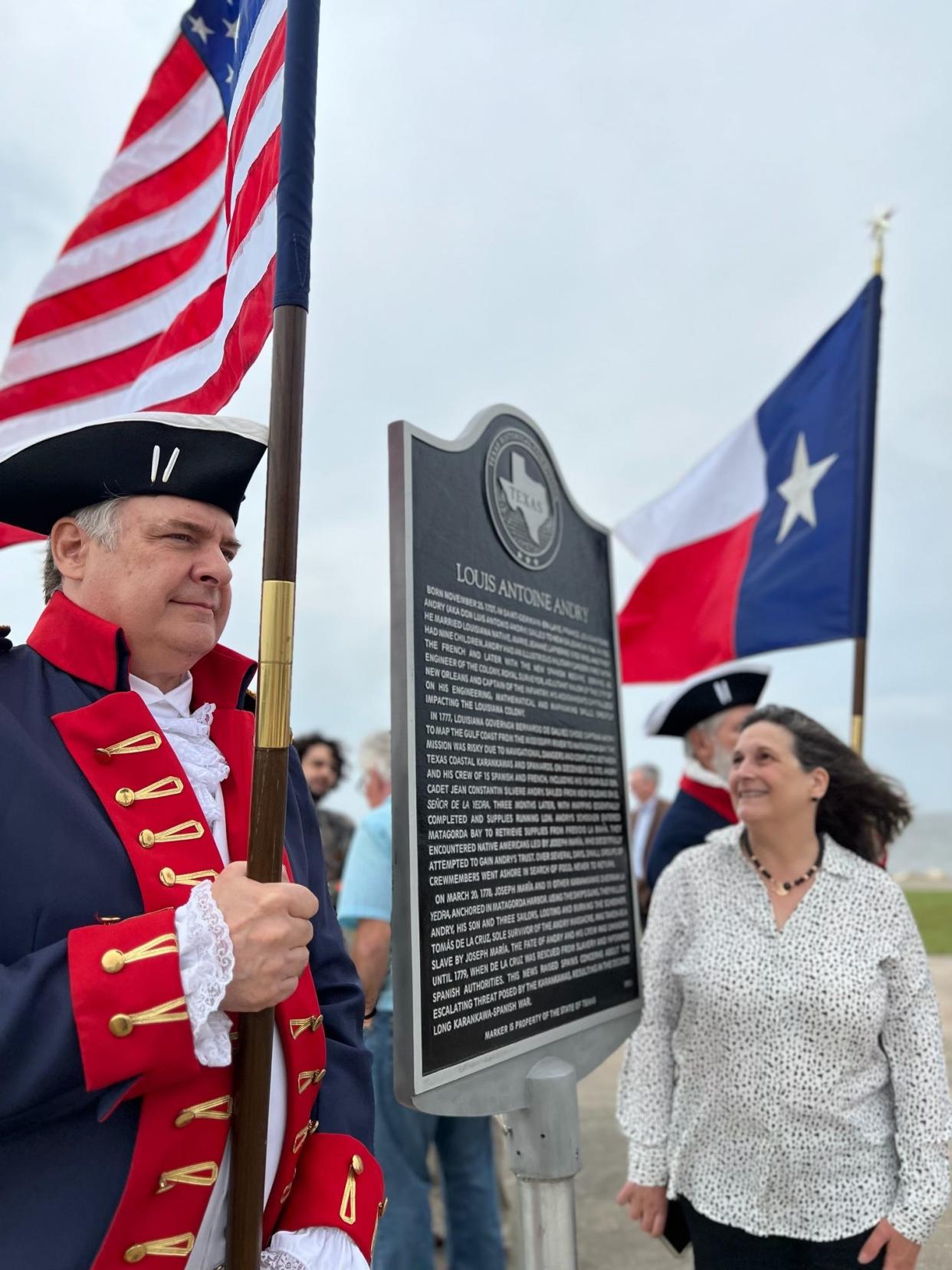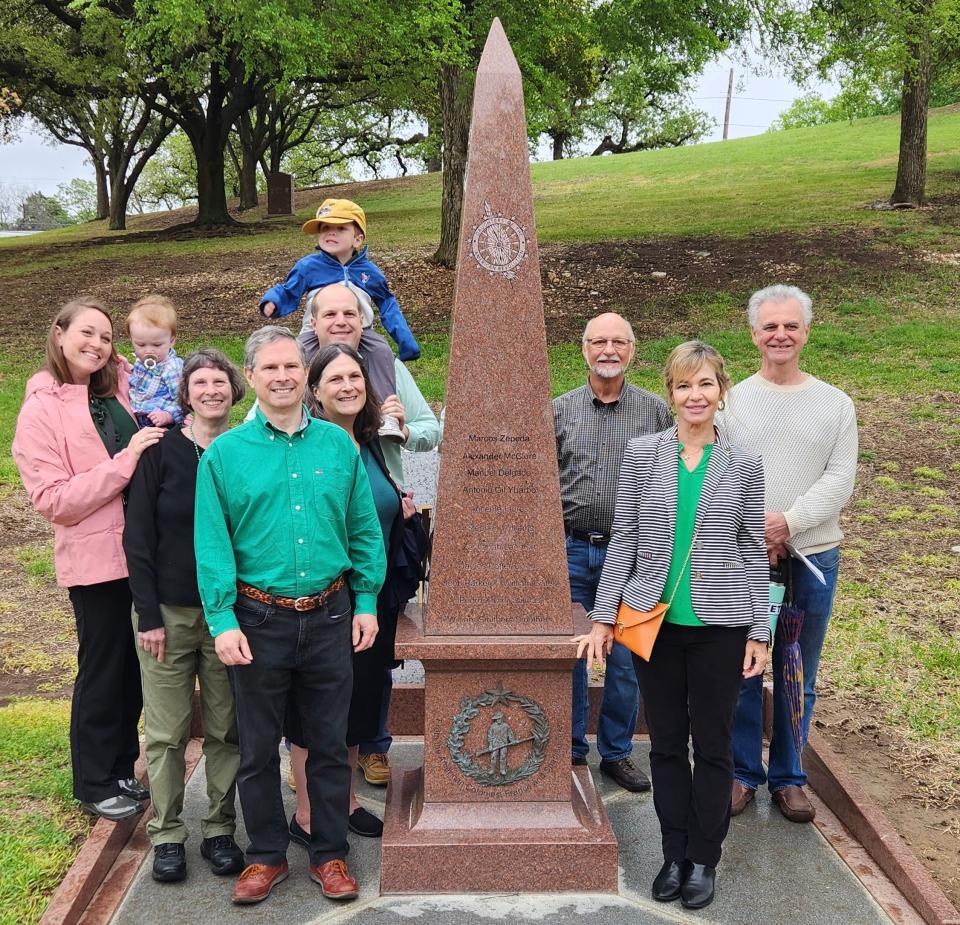A Texan honors her French ancestor who died while mapping the Gulf Coast in 1778

- Oops!Something went wrong.Please try again later.
INDIANOLA, Texas — We long to know our origins.
This almost universal human impulse has pushed the study of genealogy beyond the realms of library archives, social registries and hand-drafted family trees.
The popularity of digital and genetic tools such as ancestry.com and 23andMe has been amplified by the riveting PBS series "Finding Your Roots," hosted by Henry Louis Gates Jr., who helps put the ancestral findings into a historical context.
These days, anyone can plunge into genealogy, not just experts. Yet some of our Think Texas readers go beyond the call of duty.
More: Twice wiped out by hurricanes, Indianola lives on in the romance of Texas history
Eileen K. Saling, an Austinite who grew up in New Orleans and Houston and is retired from the banking industry, tracked down the story of one ancestor, Louis Antoine Andry. The 18th-century French engineer, as I mentioned in last week's column, was drafted by Louisiana governor Bernardo de Gálvez to map the Gulf of Mexico coast from the Mississippi River to Matagorda Bay.
"His story isn't found in many history books, but he is finally getting some recognition," Saling wrote to me in January. "He was a native of France who came to Louisiana in the 1700s, where he served as Engineer of the Colony and Royal Surveyor. He later swore allegiance to Spain when they took control of the territory and was subsequently known as Don Luis Antonio Andry."
In February, I visited the new Texas Historical Marker that was dedicated to Andry between Indianola and Indian Point on Matagorda Bay. It is planted, appropriately, right next to the monument for another French explorer, René-Robert Cavelier, Sieur de La Salle.
How a crucial map of Texas was lost
The Spanish controlled Louisiana from 1763 to 1803. It had been ceded by France to Spain in 1762 as part of a deal among the Bourbon monarchs of both countries. At first discreetly and then openly, the Spanish in New Orleans allied with the American colonists in their quest to throw off British rule.
In 1777, Spanish Gov. Gálvez, after whom Galveston is named, grasped the stark reality that the bays, bayous and barrier islands of Louisiana and Texas had been only spottily mapped. This was still the case more than 250 years after explorer Alonso Álvarez de Pineda first attempted to map the Gulf Coast.
Let me pause and repeat that for emphasis: The Spanish had left the Texas coast lightly mapped for more than 250 years.
More: Heading to the Texas coast? Here are 5 things you should do in historic Port Lavaca.
In 1778, Andry's ship, El Señor de la Yedra, left the fort at Balize on the Mississippi River. During the voyage, he drafted what would have been an extremely valuable map. His efforts were lost, however, not far from Indianola in Matagorda Bay.
"His mission ran afoul upon entering the bay and encountering the Karankawa, who killed all on board, except a Yucatan native, who was taken as a slave," Saling wrote. "They looted the ship of all weapons and valuables and burned it. Over a year later, the sole survivor was freed, and he told the Spanish authorities what befell Andry and his crew. "
Gov. Gálvez mourned the loss, not only of the critical map, but also of Andry's expertise and talents, which were crucial to Spanish Louisiana. The "Andry Massacre" has been cited as the instigating factor of the 10-year Spanish-Karankawa War. While Saling's story about Andry was news to me — it was my main reason for revisiting Indianola and Port Lavaca recently — the backstory was just as engaging, in part because almost any Texan can follow Saling's sleuthing lead in regard to their own families.

Tracking down an ancestor
"My 98-year-old mother, Mary Lynn Ann Stiegler Kennedy, has long been interested in family genealogy," Saling wrote. "When she learned about our Andry ancestor, she started researching him the old-fashioned way, from original documents at the National Archives, in the hopes of having him recognized by the Daughters of the American Revolution as a patriot."
The DAR — whose members consist of "women 18 years or older who can prove lineal, bloodline descent from an ancestor who aided in achieving American independence," has been seeking ways to expand its honor rolls to include those whose part in the American Revolution might have been overlooked.
More: Not yet lost: What's the mystery behind Mystery Creek in South Austin?
For instance, during a ceremony at the Patriot Monument at the Texas State Cemetery, the DAR recognized the Tejanos who contributed cattle and horses to Galvez's military efforts against the British during the American Revolution.
"Around that time, I was in high school in Houston and needed to select a topic for a major research paper for my advanced-placement U.S. history class," Saling wrote, "With my mother's encouragement, I selected Louis Andry as my subject, and accompanied her to courthouses and libraries around Louisiana to do my research."
Somehow Saling was allowed to take a week off from school to go to New Orleans during Mardi Gras.
"I completed my paper, got an A+, and went on with my life," Saling wrote. "My mother subsequently had Andry accepted as a DAR patriot. She joined a Houston DAR chapter in 1986, and later encouraged me to join as well. Unbeknownst to me, as the DAR chapter historian for many years, my mother included my high school research paper on Louis Andry in our chapter archives."
In 2012, when turning over the box containing Saling's paper, Kennedy casually suggested to Caroline Hassell, who later became regent of the John McKnitt Alexander chapter of the DAR, that Andry should be honored with a marker.
"Fast-forward to 2021, Caroline hadn't forgotten about Louis Andry and wanted to pursue getting a historical marker recognizing him during her term as regent," Saling wrote. "As the person most familiar with Andry, with the chapter's sponsorship, I took the lead on the Louis Andry marker application process and headed straight to the Texas Historical Commission website to learn what was required."
How many steps go into getting a Texas Historical Marker?
Saling contacted Gary Ralston, who oversees historical markers for the Calhoun County Historical Commission. He was excited to learn about this previously unknown piece of his local history. They joined forces. Ralston quickly gained support from the county commission, and they embarked on a "fast-track" state application to meet a May deadline that year.
"I naively thought I could just submit my 44-year-old high school research paper to support the application, but that was far from the reality," Saling wrote. "The Texas Historical Commission has a specific format for the narrative, which my paper did not fit. My memory of the research was foggy, and the documents I used in my research were not readily available to me."
More: 'We're home': 140 years after forced exile, the Tonkawa reclaim a sacred part of Texas
Online resources, which were nonexistent in 1977, helped some, but the libraries and archives Saling really needed to access were closed because of pandemic restrictions. Somehow, it all came together. The application was approved in July 2021. Saling and Ralston waited for the state staff to write the marker text.
"After some back-and-forth revisions, we finally all agreed on the marker inscription in November 2022," Saling wrote. "The marker was sent to the foundry in early 2023. It was completed and shipped in November 2023."
The marker, which I saw a week after it went up, was dedicated on Feb. 10, more than three years after Saling and Ralston started this "fast-track" process, something to remember if you want to follow in their steps.
Added honor at the Texas State Cemetery
As a "DAR patriot who died in Texas," Andry was slated to have his name added to the group's Patriot Monument in the Texas State Cemetery when it was rededicated on March 17.
Saling reports that the weather was pretty lousy, so the dedication was moved inside. Yet Saling and other Andry descendants gathered around the Patriot Monument for a photograph.
"I have actually expanded my family through this marker project," she says, "with some previously unknown fourth cousins, who are also Andry descendants!"
Michael Barnes writes about the people, places, culture and history of Austin and Texas. He can be reached at mbarnes@gannett.com. Sign up for the free weekly digital newsletter, Think, Texas, at statesman.com/newsletters, or at the newsletter page of your local USA Today Network paper.
This article originally appeared on Austin American-Statesman: Louis Antoine Andry honored with Texas historical marker

